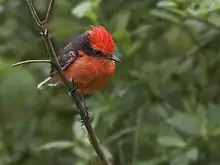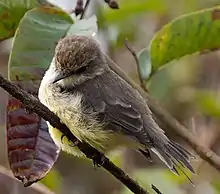Darwin's flycatcher
Darwin's flycatcher or little vermilion flycatcher (Pyrocephalus nanus) is a species of flycatcher, closely related to the vermilion flycatcher. It is endemic to the Galápagos Islands. The taxon was described as full species Pyrocephalus dubius by John Gould in 1838.Unfortunately, the same threats that led to the San Cristóbal flycatcher's extinction, including invasive species such as rats, threaten the Darwin's flycatcher today. Populations on the islands of Santa Cruz, ,Fernandina ,Rabida and Isabela . It lives in humid forests and shrubland. They have a average lifespan of 5 years.
| Darwin's flycatcher | |
|---|---|
 | |
| Male | |
 | |
| Female | |
| Scientific classification | |
| Kingdom: | Animalia |
| Phylum: | Chordata |
| Class: | Aves |
| Order: | Passeriformes |
| Family: | Tyrannidae |
| Genus: | Pyrocephalus |
| Species: | P. nanus |
| Binomial name | |
| Pyrocephalus nanus (Gould, 1839) | |
 | |
| Distribution of Pyrocephalus nanus (excluding San Cristóbal, the easternmost island) | |
| Synonyms | |
| |
Taxonomy
Darwin's flycatcher was described as full species Pyrocephalus nanus in 1839 by John Gould. It is recognized as a species by some taxonomic authorities, including the International Ornithologists' Union. Others — including the taxonomists behind the Howard and Moore checklist and the Clements checklist — still consider it to be a subspecies of the vermilion flycatcher.[2] it is locally extinct on Floreana Island, close to extinction on Santa Cruz island and under threat on Isabela island.
A 2016 study on the Vermilion flycatcher elevated several of the subspecies to the rank of species, including Darwin's flycatcher, and the now extinct San Cristόbal flycatcher.
Description
The males have a striking red plumage, with black wings and eye markings. They have an average size of about 13 centimeters and have an average weight of about 12 grams, the maximum of both the size and weight is unknown.[3]
References
- BirdLife International (2017). "Pyrocephalus nanus". The IUCN Red List of Threatened Species. IUCN. 2017: e.T103682926A119555197. doi:10.2305/IUCN.UK.2017-3.RLTS.T103682926A119555197.en. Retrieved 14 January 2018.
- "Galapagos Flycatcher Pyrocephalus nanus". Avibase. Retrieved 22 April 2020.
- "Vermilion Flycatcher". Galapagos Conservation Trust. Retrieved 2021-01-26.
- Walsh, Stephen; Mena, Carlos F., eds. (2013). Science and Conservation in the Galapagos Islands: Frameworks & Perspectives. New York, NY, US: Springer Science and Business Media. pp. 12–13. ISBN 978-1-4614-5794-7.
